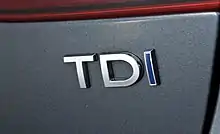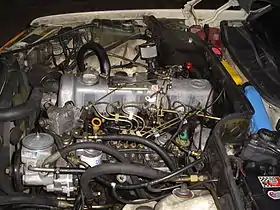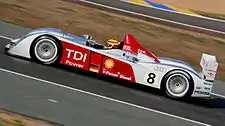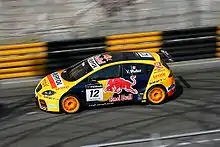TDI (engine)
TDI (Turbocharged Direct Injection) is Volkswagen Group's term for its current common rail direct injection turbodiesel engine range that have an intercooler in addition to the turbo compressor.[1][2]



TDI engines are used in motor vehicles sold by the Audi, Volkswagen, SEAT and Skoda marques, as well as boat engines sold by in Volkswagen Marine[3][4][5] and industrial engines sold by Volkswagen Industrial Motor.[6][7]
The first TDI engine, a straight-five engine, was produced for the 1989 Audi 100 TDI sedan. In 1999, common rail fuel injection was introduced in the V8 engine used by the Audi A8 3.3 TDI Quattro. From 2006 until 2014, Audi successfully competed in the LMP1 category of motor racing using TDI engine-powered racing cars.
TDI engines installed in 2009 to 2015 model year Volkswagen Group cars sold through 18 September 2015 had an emissions defeat device,[8][9] which activated emissions controls only during emissions testing. The emissions controls were suppressed otherwise, allowing the TDI engines to exceed legal limits on emissions.[10] Volkswagen has admitted to using the illegal device in its TDI diesel cars.[11]
Overview
TDI is the combination of two existing diesel engine technologies:
- Direct injection— where a fuel injector sprays the diesel fuel directly into the main combustion chambers. This causes a more complete combustion process than using a pre-combustion chamber (known as indirect injection), which therefore increases the torque output and reduces the exhaust emissions.[1][2]
- Turbocharging— where an exhaust-driven turbine compresses the intake air, functioning as an energy rectification device in order to obtain a higher thermal efficiency and increase power and torque outputs while lowering fuel consumption per kilowatt and carbon emissions, also as an airpump it technically enables increasing combustion volume of a small displacement engine, however this is only of worth to racing and military applications seeking to maximize nominal power output with out benefit of, or taking into consideration fuel consumption or thermal efficiency.[1][2]
Most TDI engines also use an intercooler to lower the temperature (and therefore increase the density) of the compressed air before it enters the cylinder.[1][12]
Similar technology has been used by other automotive companies, but the "TDI" marketing term is only used by Volkswagen Group and Land Rover. Volkswagen Group uses the term SDI (which stands for "Suction Diesel Injection") for its naturally aspirated (i.e. non-turbocharged) direct-injection diesel engines.
History

Prior to Volkswagen Group's first TDI engine, the first turbocharged diesel engine used in a passenger car was an indirect injection five-cylinder engine fitted to the 1978 Mercedes-Benz 300SD (W116) 300 SD sedan.[13] The first turbodiesel engine with direct injection was the 1986 Fiat Croma 2.0 TD i.d. liftback sedan.[14]
Three years after the Fiat Croma, Volkswagen Group's first TDI engine was introduced in the 1989 Audi 100 TDI sedan.[15][16] The Audi 100 was powered by the Volkswagen 2.5 R5 TDI straight-five engine which used an electronic distributor injection pump (called "VerteilerPumpe" by Volkswagen) and two-stage direct injection. The initial version of this engine generated 88 kW (118 hp) at 3,250 rpm and 275 N⋅m (203 lb⋅ft) at 2,500 rpm.
TDI engines using common rail fuel injection (using piezoelectric fuel injectors) were introduced with the Volkswagen Group 32v TDI V8 engine used in the 1999 Audi A8 3.3 TDI Quattro, two years after the 1997 Alfa Romeo 156 2.4-L JTD became the first passenger car to use common rail injection.[17][18]
In 1999, the Volkswagen 1.2-litre TDI won the International Engine of the Year categories for "1.0 to 1.4 litres" and "Best Fuel Economy".[19]
In 2000, a fuel system using unit injectors (called "Pumpe Düse" by Volkswagen) began to replace the distributor injection pump systems (except for the V8 engine, which used common rail design).[1] In 2003, upgraded fuel injectors using a piezoelectric design began to replace the previous solenoid-operated unit injectors.
Since 2009, most of the Volkswagen Group TDI engines have switched from unit injectors to common rail injection.
Emissions testing falsification
On 18 September 2015 the US EPA and California Air Resources Board served notice to VW that approximately 480,000 VW and Audi automobiles equipped with 2.0 TDI engines sold in the US between 2009 and 2015 had an emissions compliance defeat device installed.[8][9] The defeat device, in the form of specially crafted engine management unit firmware, detects emissions testing conditions, and in such conditions will cause the vehicle to comply with emissions regulations by properly activating all emissions controls. However, under normal driving conditions, the emissions controls are suppressed, allowing the engine to produce more torque and get better fuel economy, at the expense of emitting up to 40 times more nitrogen oxides than allowed by law.[10] Such NOx emission levels are not in compliance with US regulations. VW has since admitted to these allegations, and said that the illegal software was in use in its diesel cars worldwide, affecting some 11 million vehicles.[11]
Motor racing

The first TDI engine used by Volkswagen Group for motor racing was in the Audi R10 TDI, which competed in the Le Mans Prototype (LMP) class of sports car racing. The Audi R10 recorded a victory on its debut at the 2006 12 Hours of Sebring race[20][21][22] and then at the 2006 24 Hours of Le Mans race, with both results being the first time that a diesel-powered car had won each race.[23][24][25] In the nine years from 2006 to 2014, the R10 and its successors (R15 and R18) won the 24 Hours of Le Mans eight times (the 2009 race was won by another diesel-powered car, the Peugeot 908 HDi FAP).

In the World Touring Car Championship (WTCC) racing series, the SEAT León TDI won the 2008 championship and the 2009 championship for drivers and manufacturers.[26][27] In 2008, the SEAT Leon TDI also competed in the British Touring Car Championship (BTCC) and became the first diesel car to win a round of the championship when it won the round at Donington Park.[28]
See also
References
- "Technology – TDI – Super-efficient diesel engines for power with economy". Volkswagen.co.uk. Volkswagen UK. 2010. Retrieved 4 March 2010.
- "Volkswagen AG – TDI Technical Glossary". Volkswagen.com. Volkswagen AG. Retrieved 5 November 2009.
- "Volkswagen Marine > Engines <". www.vw-m.de. Volkswagen Group. 2009. Archived from the original on 19 July 2011. Retrieved 4 November 2009.
- "Boat engines from Volkswagen Marine – Self-study programme M001 – Design and function" (PDF). www.vw-m.de. Volkswagen Marine. April 2001. Archived from the original (PDF) on 19 July 2011. Retrieved 18 February 2010.
- "Boat engines from Volkswagen Marine – Self-study programme M002 – Design and Operation" (PDF). www.vw-m.de. Volkswagen Marine. August 2006. Archived from the original (PDF) on 19 July 2011. Retrieved 18 February 2010.
- "The SDI 1.9 Industrial Engine" (PDF), www.mi-uk.com, Volkswagen AG, March 2005, archived from the original (PDF) on 14 July 2011, retrieved 4 November 2009
- "TB 20 addendum – Technical Bulletin for Volkswagen Group timing belt renewal intervals" (PDF). Gates.com. Retrieved 4 November 2009.
- Phillip A. Brooks (18 September 2015). "VW Notice of Violation, Clean Air Act (18 September 2015)" (PDF). US Environmental Protection Agency. Retrieved 20 September 2015.
- "EPA, California Notify Volkswagen of Clean Air Act Violations". US Environmental Protection Agency. 18 September 2015. Retrieved 20 September 2015.
- Jack Ewing and Coral Davenport (20 September 2015). "Volkswagen to Stop Sales of Diesel Cars Involved in Recall". New York Times. Retrieved 21 September 2015.
- "Volkswagen Says 11 Million Cars Worldwide Are Affected in Diesel Deception". The New York Times. 22 September 2015. Retrieved 22 September 2015.
- "Turbo Diésel Inyección Directa, cómo funcionan". www.ro-des.com (in Spanish). Retrieved 29 October 2019.
- "300 SD". www.mercedes-benz-publicarchive.com. Retrieved 27 October 2019.
- "Air technologies - Heritage". fiat.com. Archived from the original on 2013-01-08. Retrieved 2013-01-17.
- "8 Cars That Tell the History of Diesel in the U.S." www.MotorBiscuit.com. 13 April 2017. Retrieved 27 October 2019.
- "History". www.audi-mediacenter.com. Retrieved 27 October 2019.
- "New Powertrain Technologies Conference". autonews.com. Archived from the original on 2013-07-03. Retrieved 2008-04-08.
- "The new Audi A8 3.3 TDI quattro: Top TDI for the luxury class". www.audiworld.com. Retrieved 27 October 2019.
- "Previous Winners". www.ukimediaevents.com. Retrieved 29 October 2019.
- "12 Hours of Sebring". Audi Canada website. Audi Canada. Retrieved 11 January 2013.
- "2006 Audi R10". www.topspeed.com. 4 October 2006. Retrieved 11 January 2013.
- "Bosch Clean Diesel Helps Audi Dominate American Le Mans Series". Bosch website. Bosch NA. Retrieved 11 January 2013.
- Richards, Giles (17 June 2012). "Audi is first manufacturer to take Le Mans 24 Hours race with hybrid". guardian.co.uk website. London: The guardian. Retrieved 11 January 2013.
- "Audi R10 TDI – a history maker". Audi UK website. audi.co.uk. Retrieved 11 January 2013.
- "Audi on course for a 10th victory ?". www.LeMans.org. Retrieved 11 January 2013.
- "SEAT Leon TDI: A double-double world champion". WTCC season review. London: The guardian. 18 December 2009. Retrieved 12 January 2013.
- "Year by year SEAT's racing history". SEAT sport website. SEAT sport. Archived from the original on 13 March 2012. Retrieved 12 January 2013.
- "BTCC race reports 04/May/2008". BTCC Donington Park. BTCC. Retrieved 12 January 2013.